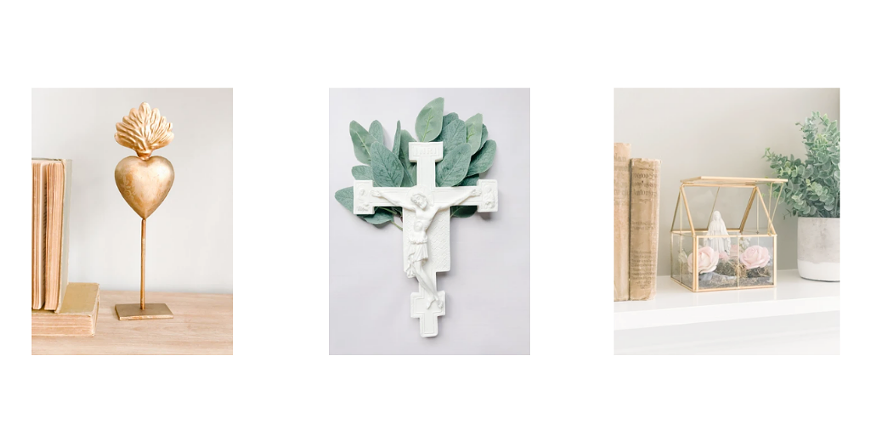
The Essential Decorating Aspects of A Catholic Home
It is interesting to note that the Catholic Church has been able to permeate every aspect of our lives. There are secular ways of doing things, and then there is the Catholic church's way of doing something. This is due to the fact that the Catholic church has a long tradition that stretches back over 2000 years. Throughout history, the Catholic Church provided not only religious guidance but law and organization throughout the world.
Additionally, it provided guidance in cooking and decorating, which began to take on a distinctive Catholic feel. As times have changed, modern influences have affected the typical Catholic home, but this has given more choices as a decorator.
While there may be some differences, the vast majority of Catholic homes will have at least three things in common compared to other families. The first is a small font, which is filled with holy water, typically at the entrance of a home. These fonts are mounted by the front door and are much like those found in the doorway of your parish church. Upon entering and leaving home, this makes it possible for you and your guests to bless yourselves with holy water.
The blessing gesture which is performed by creating the sign of the cross is meant to serve as a reminder that the home is a sanctuary or holy place which has been consecrated to God. For those that ask to be blast are asking for the guidance of God in everything that they do. Your houseguests may not fully understand the purpose of a font. Still, it is one that can be explained quickly, and even those not of the Catholic faith can become excited about holy water and being able to bless themselves. This is a beautiful tradition to have in the home and one of the most common practices throughout Catholic homes around the world.
The second most common feature of Catholic homes is the presence of the crucifix throughout the house. In most homes, a cross or crucifix will be found in the living room as well as every bedroom. The living room cross is generally located above the door.
During Roman history, individuals did not have a home address, so they indicated the owner the home with the plaque above the door that was known as a "titulus". We no longer have this type of practice. Instead, we now have impersonal numbers to address where we live. However, the vast majority of Catholic homes will post a crucifix above the doorway, indicating the importance of Christ for the family. This means that the residence belongs to Christ first and that his sacrifice has been accepted by all who live within the home. This is also a reminder that Jesus is welcome within the home.
In the bedroom, the crucifix will generally be placed on any available wall and in the children's room, a tiny crucifix may be tied to the curtain. There is also a Catholic tradition that has been reserved for individuals who work in dangerous jobs. When the worker gets ready to depart the home, the crucifix would be removed from the wall and kissed the statue of Jesus, finally laying it on the pillow until his safe return.
The presence of the crucifix in any room is a powerful reminder of the faith the family feels and helps to provide a focal point during prayer.
While the use of the statuary is a common feature, it is typically reserved for the final feature of the Catholic home, which is the shrine or altar.
Throughout the world, the vast majority of Catholic homes will maintain a specific spot in their homes that remain as a focal point for religious activity. This area may be a decorated dresser or table, but regardless of what it is, it is primarily reserved for God and the saints.
These areas are generally decorated with an icon or statue. There'll be one candle available to signify prayers and help to serve as an offering. During special occasions when an individual or the family must make a special petition to God, this area is used for exceptional devotion.
It is also extremely important that these areas are well-lit and illuminated. This can be especially true if the area is located in a section of the house where there are very few windows, natural light, and pre-existing lighting fixtures. In most Catholic homes, this area is the most important to the family, so it must be highlighted.
The type of fixture and style of light is also nothing to be overlooked as well. Whether the homeowners decide to utilize a local Charlotte lighting showroom or find the perfect lighting fixture online to exemplify their shrine, it is of the utmost importance that the fixture directly highlights the area and does so in a clear, white or light yellow light.
Many of these house features are viewed oddly by non-Catholics, typically the American Protestant, who will not share the pertinent Catholic tradition. By having these focal points within your home, it serves as an opportunity to share your faith with other individuals, if they should show an interest.
For some families wearing Christian enamel pins is a way of expressing their faith and support. These pins can be worn on clothing, hats or scarves as Christian faith apparel accessories, or they can be placed on pin display stands as room decor items to decorate a room. GS-JJ supports the ability to design different Christian symbols, Bible character patterns or a passage of text in the Bible for free customization. It can also be used as a gift for Christian friends, or distributed to people who participate in Christian activities. Such gifts are very fashionable, with mission Oriented, Christ-centered, as a spiritual teacher, spreading the love of God, Go Website.
Always understand that the space within your home is yours and fully represents you and your beliefs. There are some beautiful catholic art pieces, check the collection here. If the faith you hold is vital to you, it must be reflected in the space surrounding you. You should always be proud of your home, regardless of how humble it may be. Take the time to properly decorate your home and allow your faith to shine through in every single room.
Speaking of...
-

Angel Tree Kids Still Need Sponsors in Greater Charlotte Area for Christmas
Nov 11, 2020 -

Faith and Spirituality Among Us All
Oct 22, 2020 -

Keeping The Faith, A Christian Take
Jun 7, 2020 - More »
More by CL Contributor
-

How To Prepare For Drug Rehabilitation
Jul 30, 2025 - More »









